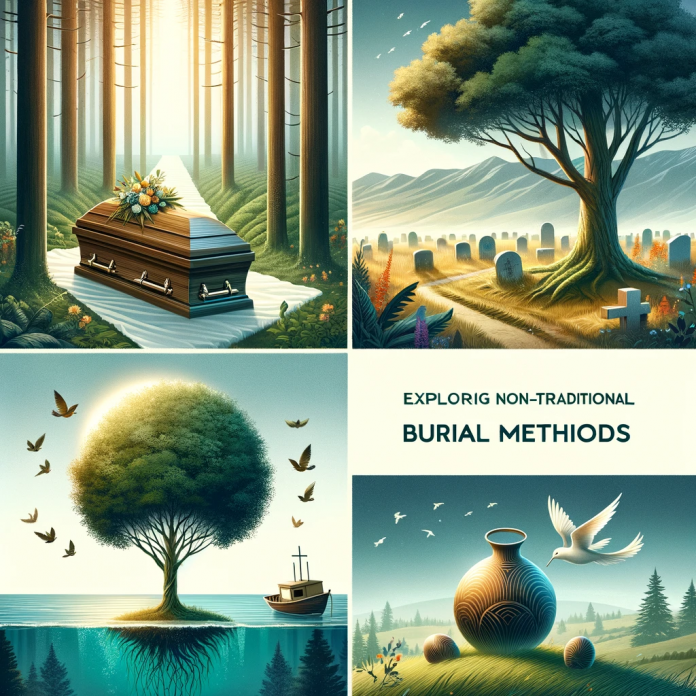As society evolves, so do our practices and traditions. This is especially true when it comes to the final rites of passage: burial methods. In recent years, there has been a significant shift towards non-traditional burial methods. These alternatives not only offer unique ways to commemorate loved ones, but they also often have less environmental impact than conventional methods. This article delves into the world of non-traditional burial methods, exploring their origins, significance, and the reasons behind their growing popularity.
Understanding Non-Traditional Burial Methods
Non-traditional burial methods are those that deviate from the conventional practices of embalming, casket burial, or cremation. These methods often focus on reducing environmental impact, personalizing the burial process, or adhering to specific religious or cultural beliefs.
While these methods may seem new or unconventional to some, many have roots in ancient practices or traditions. They offer a way to remember and honor the deceased in a manner that aligns with their values and beliefs.
Environmental Impact of Traditional Burial Methods
Traditional burial methods, particularly embalming and casket burial, have significant environmental implications. Embalming involves the use of chemicals, many of which are harmful to the environment. Casket burials, on the other hand, require large amounts of wood and metal, and occupy valuable land space.
Furthermore, traditional burial methods often involve the use of non-biodegradable materials, leading to long-term environmental harm. This has led to a growing interest in eco-friendly burial methods that minimize environmental impact.
Types of Non-Traditional Burial Methods
There are several types of non-traditional burial methods, each with its unique characteristics and benefits. Here, we explore some of the most popular ones.
Natural or Green Burials
Natural or green burials aim to return the body to the earth in the most natural way possible. This involves the use of biodegradable caskets or shrouds, and the body is not embalmed. The goal is to allow the body to decompose naturally, nourishing the surrounding soil.
Green burials not only reduce environmental impact but also offer a way to connect with nature in the final stages of life. They can be personalized to reflect the deceased's love for the outdoors or their commitment to environmental conservation.
Water Burials
Water burials, also known as sea burials, involve the scattering of ashes or the sinking of the body in a biodegradable urn or casket into the ocean. This method has roots in maritime traditions and is often chosen by those with a deep connection to the sea.
While water burials have a minimal environmental impact, they require careful planning and adherence to regulations to ensure they are carried out respectfully and legally.
Tree Burials
In a tree burial, the deceased's ashes are mixed with soil and a tree seed, then planted. The tree serves as a living memorial, growing and thriving with the nutrients from the ashes.
Tree burials offer a way to commemorate the deceased in a tangible, lasting way. They also contribute positively to the environment by promoting reforestation and biodiversity.
Choosing a Non-Traditional Burial Method
Choosing a non-traditional burial method is a deeply personal decision that should reflect the deceased's values, beliefs, and preferences. Here are some factors to consider when making this choice.
Personal Beliefs and Values
One's beliefs and values play a significant role in choosing a burial method. For instance, those with strong environmental convictions may prefer a green burial, while those with a deep connection to the sea may opt for a water burial.
It's essential to have open and honest discussions about these preferences well in advance, ensuring that the chosen method aligns with the deceased's wishes.
Cost Considerations
Non-traditional burial methods can vary significantly in cost, depending on the specific method and any additional services or products required. It's important to research and compare costs to make an informed decision that fits within the budget.
While some non-traditional methods may be more expensive upfront, they often result in lower long-term costs, as they eliminate the need for a burial plot or maintenance fees.
Legal and Regulatory Requirements
Each burial method comes with its own set of legal and regulatory requirements. For instance, water burials must be carried out at a certain distance from the shore, and certain types of green burials may only be performed in designated natural burial grounds.
It's crucial to understand these requirements and ensure that the chosen method can be carried out legally and respectfully.
Conclusion
Non-traditional burial methods offer a unique and meaningful way to commemorate loved ones, while often reducing environmental impact. Whether it's a green burial, a water burial, or a tree burial, these methods provide a way to honor the deceased in a manner that aligns with their values and beliefs.
As society continues to evolve, it's likely that we'll see even more innovative and personalized burial methods emerge. By exploring these options and having open discussions about end-of-life preferences, we can ensure that our final rites of passage are as unique and meaningful as the lives we've lived.


-banner.png)





